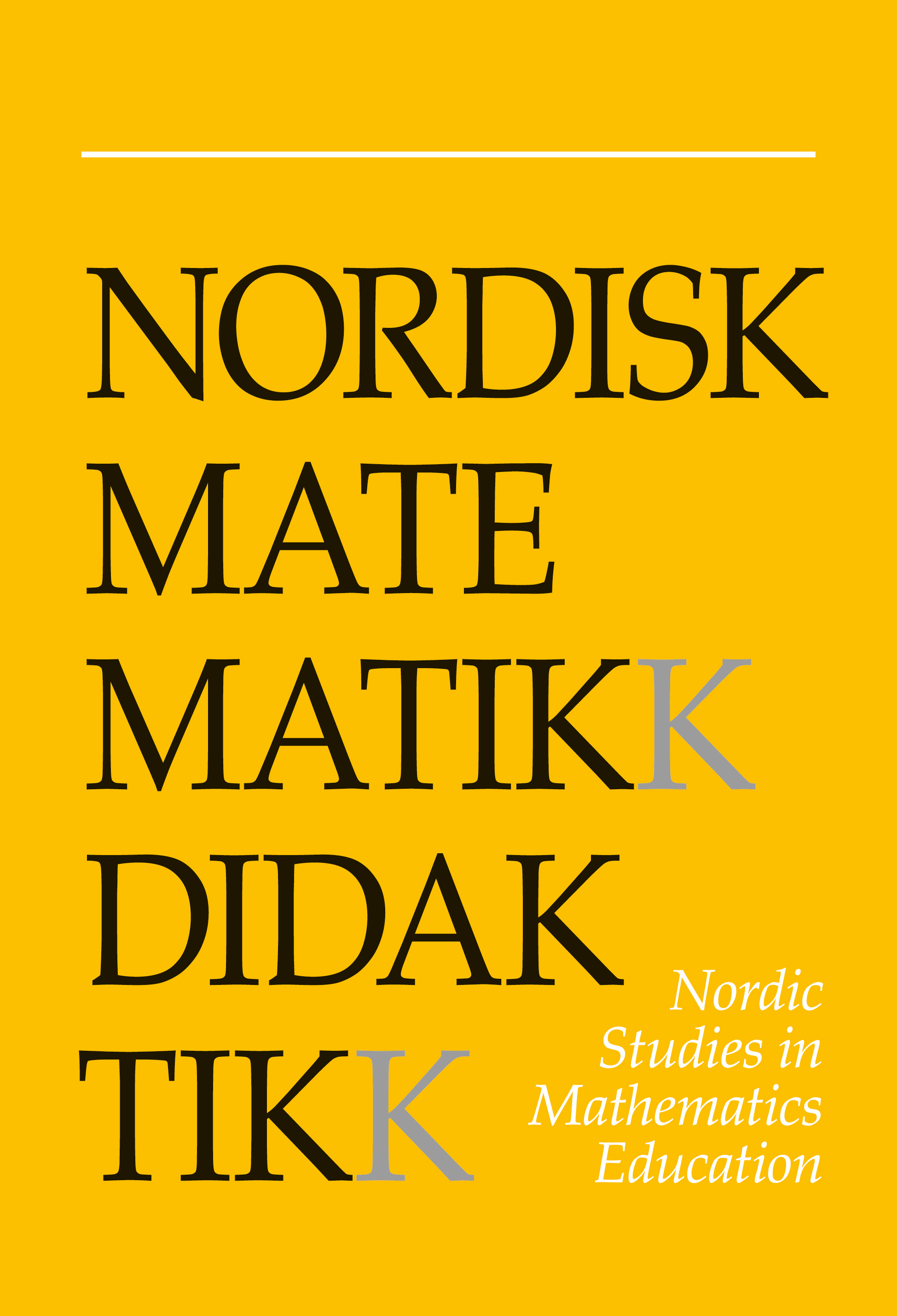Computer support for diagnostic teaching – the case of decimal numbers
DOI:
https://doi.org/10.7146/nomad.v6i3-4.146649Abstract
Computers with different kinds of software were used in mathematics teaching during one school year with Norwegian students of age 10–14. The development of students' understanding of decimal numbers was investigated, using computers to support a diagnostic teaching approach. In particular some spreadsheet tasks were used to stimulate mathematical investigations and to generate discussions exhibiting conflict. An item analysis of pre-test data revealed a common pattern of misconceptions on decimal numbers. As the students worked on the spreadsheet tasks, their concepts seemingly were in conflict with what they observed. This led the students into lively discussions. The test results indicated that the computer group improved significantly by comparison with the control group on part of the test, with the greatest improvement from the 'high' spreadsheet users in the research group.
References
Beare, R. (1993). How Spreadsheets can aid a variety of Mathematical Learning Activities from Primary to Tertiary level. In B. Jaworski (Ed.). Proceedings of Technology and Mathematics Teaching. Birmingham:
Bell, A. (1993a). Principles for the design of teaching. Educational Studies in Mathematics, 24(1), 5-34. https://doi.org/10.1007/BF01273293
Bell, A. (1993b). Some experiments in diagnostic teaching. Educational Studies in Mathematics, 24(2), 115-137. https://doi.org/10.1007/BF01273297
Bell, A., Fischbein, E. & Greer, B. (1984). Choice of operation in verbal arithmetic problems. The effects of number size, problem structure and context. Educational Studies in Mathematics, 15(2), 127-147. https://doi.org/10.1007/BF00305893
Bell, A., Greer, B., Grimson, L. & Mangan, C. (1989). Childrens' performance on multiplicative word problems: Elements of a descriptive theory. Journalfor Research inMathematics Education, 20(5),434-449. https://doi.org/10.5951/jresematheduc.20.5.0434
Bell, A., Swan, M., Onslow, B.A., Pratt, K. & Purdy, D. (1985). Diagnostic Teaching. Teaching for Long Term Learning. Nottingham: Shell Centre for Mathematical Education.
Bennett, J.P. (1991). Effectiveness of the Computer in the Teaching of Secondary School Mathematics: Fifteen Years of Research. Educational Technology, 31(1), 44-48.
Bigge, M.L. & Shermis, S.S. (1992). Learning theoriesfor teachers. New York: Harper Collins Publishers.
Bissell, C. (1995). Models of Technology. Spreadsheets and the Language of applicable Mathematics. In L. Burton & B. Jaworski (Eds.) Technology in Mathematics Teaching (pp. 365-386). Chartwell-Bratt.
Breiteig, T. & Fuglestad, A.B. (1997). Data i matematikken. (2nd ed.) Oslo: Aschehoug.
Brekke, G. (1995). Oppfatninger av desimaltall. Nämnaren, 4, 27-34.
Brekke, G. (1996a). A decimal number is a pair of whole numbers. In L. Puig & A. Guiterrez (Eds.) Proceedings of the 20th Conference of the International Group for the Psychology of Mathematics Education (pp. 137-144). Vàlencia: Dept. de Didàctica, Universitat de Vàlencia.
Brekke, G. (1996b). Regning med desimaltall. Nämnaren, 1, 17-20.
Brekke,G. & Støren, H.(1995).Kvalitet i matematikundervisningen. Nämnaren,3,10-14.
Brown, M. (1981). Place value and decimals. In K. M. Hart (Ed.). Childrens Understanding of Mathematics:11-16 (pp.48-65). London: John Murray.
Davis, R.B., Maher, CA. & Noddings, N. (1990). Constructivist views on the teaching and learning of mathematics. Journal of Research in Mathematics Education. Monograph number 4. Reston, VA: National Council of Teachers of Mathematics. https://doi.org/10.2307/749908
Foxman, D., Graham, R., Joffe, L., Mason, K., Mitchell, P. & Sexon, B. (1984). A review of monitoring in mathematics 1987 to 1982 Part 1. APU. National Foundation for Educational Research.
Fuglestad, A.B. (1996). Computers and the understanding of mathematics. A study ofteaching decimal numbers. PhD thesis. (Forskningsserien nr. 6, 1998. Kristiansand: Høgskolen i Agder.)
Green, D., Armstrong, P. & Bridges, R. (1993). Spreadsheets: Exploring their Potential in Secondary Mathematics. The Mathematical Association.
Hart, K., Brown, M., Kerslake, D., Kuchemann, D. & Ruddock, G. (1985). Chelsea Diagnostic mathematics test..
Healy, L. & Sutherland, R. (1991). Exploring mathematics with Spreadsheets. Simon and Shuster Education.
NCET. (1996). Integrated Learning Systems. A report of Phase II of the pilot evaluation of ILS in the UK. Coventry: National Council for Educational Technology.
Phillips, R., Pead, D. & Gillespie, J. (1995). Evolving strategies for using interactive video reources in mathematics classrooms. Educational Studies in Mathematics, 28(2), 133-154. https://doi.org/10.1007/BF01295790
Resnick, N., Leonard, M , Omanson, S. & Peled. I (1989). Conceptual basis of arithmetic errors: The case of decimal fractions. Journalfor Research in Mathematics Education, 20(1), 8-27. https://doi.org/10.2307/749095
Rojano, T. (1993). Towards an algebraic Approach: The role of spreadsheets. I n I. Hirabayaski, N. Nohda, K. Shigemats & F. Lin (Eds.). Proceedings of PME XVII (1) (pp. 189-196). Tsukuba, Japan: University of Tsukuba.
Rojano, T. & Sutherland, R. (1991). Symbolising and Solving Algebra Word problems: The Potential of a Spreadsheet Environment. In F. Furninghetti (Ed.). Proceedings of PME15(3) (pp. 207-213). Assisi, Italy: University of Genova.
Sackur-Grisvard, C. & Leonard, F. (1985). Intermediate Cognitive Organizations in the Process of Learning a Mathematical Concept: the Order of positive Decimal Numbers. Cognition and Instruction, 2 (2), 157-174. https://doi.org/10.1207/s1532690xci0202_3
Swan, M. (1983a). Teaching Decimal Place Value. A comparative study of conflict and positive only approaches. In R. Herschkowitz (Ed.). Proceedings of PME VII (pp. 211-216). Haifa, Israel: Department of Science teaching. The Weizman Institute of Science
Swan, M. (1983b). The Meaning and Use of Decimals. Calculator based tests and teaching materials. Nottingham: Shell Centre for Mathematical Education.
Watson, D.M. (1993). TheIMPACTReport. London: Centre for Educational Studies. London: Kings College London.
Downloads
Published
How to Cite
Issue
Section
License

This work is licensed under a Creative Commons Attribution-NonCommercial-ShareAlike 4.0 International License.



